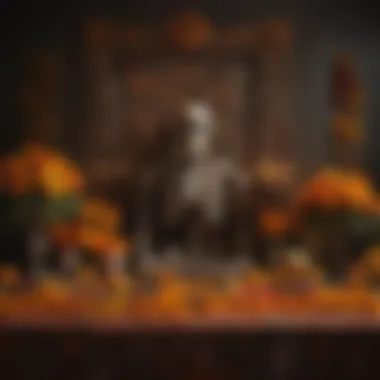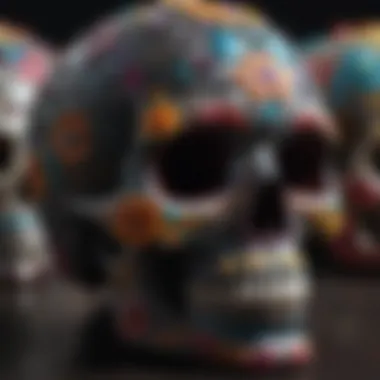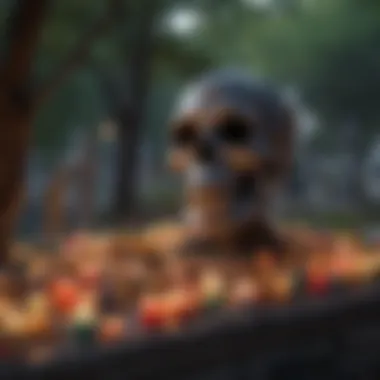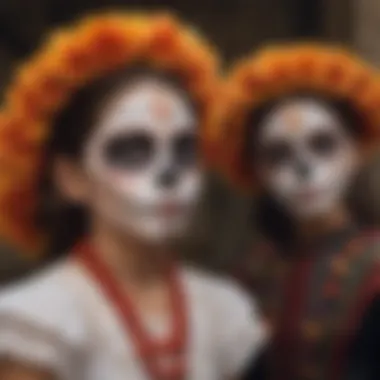Understanding Dia de los Muertos: A Cultural Exploration


Intro
Dia de los Muertos, or the Day of the Dead, is a unique holiday celebrated in Mexico and among its diaspora. This treasured time pays tribute to those who have passed away. Through vibrant traditions, creativity, and family gatherings, loved ones find a way to connect across the boundaries of life and death. It is more than a day of mourning. It serves as a celebration of life, memory, and culture, inviting families to honor their ancestors.
Moments during Dia de los Muertos are filled with color and festivity. Altars, called ofrendas, showcase photographs and artifacts representing the deceased. Symbols like marigolds and sugar skulls also play vital roles. These artifacts and symbols carry layers of tradition and reverence. Children learn the importance of memory, connection, and cultural heritage. Each family grieves, remembers, and celebrates their unique way.
Core Themes of Dia de los Muertos
The main themes of this holiday foster both understanding and appreciation. These include:
- Remembrance: Honoring passed loved ones by recalling shared memories.
- Cultural Legacy: This is a way of transmitting culture to younger generations through stories and traditions.
- Life and Death Link: Accepting death as a natural part of life, it strengthens familial ties.
Each element found in the celebrations of Dia de los Muertos makes a statement about life. Families often come together to share a meal in honor of the departed, reinforcing bonds that surpass time and space.
Fun Facts and Trivia
Did you know? There are some interesting aspects of Dia de los Muertos that capture the attention of young readers.
- The celebration occurs over two days: November 1 for children, and November 2 for adults.
- Marigolds are often called Cempasúchil, and are thought to help the spirits find their way back.
- Sugar skulls are not used just as decorations; they can be eaten too!
Children may appreciate exploring these fun trivia elements, actively engaging them in the cultural narrative.
Dia de los Muertos transcends sadness, providing hope to those left behind.
Wildlife Explorations
The essence of Dia de los Muertos also relates to notable flora. Plants, like marigolds, play crucial roles in offerings. Understanding this connection can be fruitful. Some pertinent species to explore are:
- Tagetes erecta, commonly known as African marigold.
- Cempasúchil, significant in Mexican ecosystems.
This topic can lead to quizzes, making the meanings interactive. These plants also highlight biodiversity, linking nature conservation to cultural practices.
Environmental Awareness
Cultural celebrations can highlight the importance of protecting our environment. Just as we honor those who have passed, we must also care for our living world. Teaching kids simple norms such as:
- Reducing waste during celebrations.
- Using natural materials instead of plastic for decorations.
- Understanding local biodiversity helps align memories with environmental responsibility.
This approach will show young minds the dual importance of care for nature alongside honoring family legacy.
DIY Nature Activities
Engaging kids can be fascinating through do-it-yourself (DIY) activities that tie into this holiday. Consider trying some of these at home:
- Craft your own papel picado, traditional paper cut-outs.
- Create sugar skulls, which can act both as decorations and activities to share.
- Plant marigolds in a small pot, symbolizing remembrance.


These hands-on activities provide ways to relate to the holiday in evolving ways.
In constucting the artisan expressions reflected in this holiday, young families can establish personal connections to tradition. ****
Overview of Dia de los Muertos
Dia de los Muertos, or the Day of the Dead, is more than just a holiday. It serves as a vibrant opportunity to honor and remember loved ones who have passed on. This section provides insight into why this celebration is important, focusing on special elements that make it unique and meaningful.
Definition and Significance
Dia de los Muertos revolves around a sacred and culturally rich practice. It celebrates the connection between the living and the deceased. Families create altars called ofrendas, where they place photos, belongings, and favorite foods of their deceased relatives. The significance lies not just in remembrance, but in the belief that spirits return to the Earth during this time.
The essence of Dia de los Muertos is joyous rather than sorrowful. While it embraces loss, it acknowledges the lives lived, encouraging communities to come together and reflect. Engaging with traditions fosters respect for heritage, making it important to pass down these practices to younger generations.
"In death, there is celebration of life; this understanding permeates through the customs surrounding Dia de los Muertos."
Cultural Context
To truly understand Dia de los Muertos, one must appreciate its cultural context. The observance is deeply rooted in Mexican history, intertwining ancient indigenous customs with Catholic influences introduced during Colonial times. Many cultures worldwide have similar practices of honoring their dead, but Dias de los Muertos is distinct for its rich symbols and association with joy.
Mexico celebrates this event on November 1st and 2nd, aligning with the Catholic holidays of All Saints' Day and All Souls' Day. The memory of loved ones is cherished in various ways, showing how cultural practices can unify families. Lovingly crafted marigolds and colorful sugar skulls are just a few highlights that signify the dedication made towards coexisting with the memories of those who have shaped their lives.
Understanding Dia de los Muertos helps bridge generations and creates dialogue about life, memory, and love. It invites families to explore and share stories, helping children comprehend the beauty in remembrance and cultural identity.
Historical Background
The historical background of Dia de los Muertos is critical to understanding its richness and depth. This holiday is not just a day of remembrance, but a culmination of centuries of cultural interplay. Explore this section to discover significant elements that shaped the celebration. We will see how the unique blend of indigenous wisdom and Spanish traditions has crafted a tapestry reflecting Mexico’s diverse heritage.
Origins in Indigenous Practices
Dia de los Muertos has its roots deeply planted in the ancient traditions of Indigenous peoples like the Aztecs and Purepechas. They had profound respect for death, viewing it as a continuation of life rather than an end. Often, they would celebrate death in elaborate rituals. These rituals included offerings like food, flowers, and even songs to honor the spirits of deceased ancestors.
These customs were not simply acts of grieving, but rather ways to maintain a living connection with the departed. In fact, the return of the souls to the earthly realm is marked by various phases a few days before November 2nd. People would prepare altars known as ofrendas, with items that were beloved by those who had passed. This engaging interaction with death fostered a high level of communal reverence and remembrance.
Spanish Influence
The arrival of the Spanish in the 16th century introduced a wave of new practices and beliefs into the mix. The Spanish brought with them their Catholic faith, which mingled with existing customs. This significantly shaped how the Dia de los Muertos is observed today.
For instance, the celebration coincides with the Catholic holidays of All Saints' Day and All Souls' Day. Many elements blended together seamlessly, such as the tradition of lighting candles, symbolizing the guiding light for souls. Still, it is important to note that the indigenous aspects remained strong.
Through centuries of interaction among cultures, what emerged was a holiday that honors life and tradition while respecting historical narratives. This updating and layering of traditions is essential in understanding dia de los muertos's themes and its meanings for communities today.
“Dia de los Muertos blends the sacred and the cultural seamlessly, preserving memory and encouraging remembrance.”
Key Symbols and Elements
Dia de los Muertos is rich with symbols that reflect its deep cultural roots. Each symbol holds meaning, connecting the living to the dead. Understanding these symbols helps us appreciate the holiday's significance in a personal way. These elements also show how traditions have evolved over time.


Altars (Ofrendas)
One of the most prominent symbols of Dia de los Muertos is the altar, or ofrenda. An ofrenda serves as a focal point for honoring deceased loved ones. Families create these altars in their homes or at cemeteries. They usually include items like photographs, food, and personal belongings of the deceased. The inclusion of these elements allows the family to feel the presence of their departed.
The creation of an ofrenda follows certain traditions. Typically, several layers are included, representing different parts of the journey for the dead. The top layer usually features standing images of saints and the Virgin Mary, while lower levels include offerings to the loved ones. Molé, bread, and favorite food of the departed are common offerings to honor them.
Overall, altars convey deep respect and love for those who have passed. Highlighted by candles that symbolize faith, they invite spirits to return for a brief visit. Families construct these bathed in ritual and memory, ensuring the legacy of tradition is maintained.
Sugar Skulls (Calaveras)
Calaveras, or sugar skulls, are another captivating element of Dia de los Muertos. These skulls are beautifully decorated in various colors. Unlike typical depictions of skulls, the designs are vibrant and festive, reflecting joy rather than sorrow. The sugar skulls represent the sweetness of life and the cycle of existence.
Each sugar skull is uniquely made, often personalized with the name of the deceased on the forehead. When displayed on ofrendas, calaveras remind families of their loved ones, but they also embody the belief that death is not an end. It is instead a continuation of life in a different form.
Creating sugar skulls is an art form that deeply separates this holiday from other observances of death. Those who partake in their making pass down traditions through generations. This shared activity fosters a unique bond among families, enhancing the sense of community during this time.
Marigolds (Cempasuchil)
Marigolds, specifically Cempasuchil, hold immense cultural significance in Dia de los Muertos. These bright orange flowers are believed to attract the spirits of the departed. With a distinct scent, marigolds lead the souls back to their families during the celebration.
The flowers are often scattered on ofrendas and even used to create intricate flower wreaths. They are believed to symbolize the fragility of life. Local legends suggest that the brilliance and scent of marigold flowers offer strength to the spirits on their journey.
Using marigolds shows the deep connection between nature and death. During this time, they become a bridge connecting the physical world with the spiritual. Elemental aspects like color and scent invoke powerful feelings, further enriching the experience of honoring the deceased.
As children and adults engage with these symbols and elements, they gain profound insights into the celebration. Memory, its role in life, and embrace of cultural backgrounds are fostered.
Celebration Practices
Celebration practices during Dia de los Muertos play a crucial role in how the holiday is celebrated. They allow families and communities to connect with ancestral spirits. These practices create a space for personal reflection and shared memory. Understanding these observances helps young audiences grasp not just the holiday's significance, but also deeper concepts related to life and death.
Family Gatherings
Family gatherings form the heart of Dia de los Muertos. Relatives come together, transcending physical barriers that may exist, for a shared purpose. They remember loved ones who have passed away his way families carry on tradition, perhaps preparing favorite foods of those a s loved or telling stories from the past. These gatherings combine joy and sadness, a sort of emotional spectrum that enhances the depth of the observance.
In many homes, an ofrenda is set up. This altar holds photographs, candles, and items like shoes and favorite snacks. Children help decorate the altar, which instills pride in their culture and history. Parents and family members use this opportunity to educate younger generations about their roots and the significance of remembrance.
Visiting Cemeteries
Visiting cemeteries is another cornerstone of the festivities. Families take time to honor those who have left this world. They visit gravesites, cleaning and decorating them with marigolds and sugar skulls. In this space, they might also bring picnics, sharing meals and stories of those who have departed. This practice reinforces the connection to their past through communal acts.
For children, this can be an intense emotional experience. Learning to appreciate life through understanding death highlights a unique aspect of learning. Thoughtful discussions can happen here, equipping children with ways to confront grief, while also celebrating life.
Community Events
Community events bring a broader aspect of social interaction into the picture. These events can range from parades to cultural performances. Schools may host activities that engage students in artistic expressions related to Dia de los Muertos. Here, children can learn through dance, music, and art, creating an interactive educational experience.
Sharing the festival with neighbors also fosters a sense of unity. Participants wear traditional clothing, dance, and share foods from their cultural backgrounds. This expands beyond families to a larger community narrative, highlighting diversity in celebrations.


Community events showcase the ongoing dialogue between the living and the dead, allowing people to express themselves in unique ways each year.
Overall, these celebration practices—family gatherings, visiting cemeteries, and community events—form a tapestry connecting generations. Encouraging children to understand and participate cultivates a deeper respect for those who came before. This unique approach lies at the center of Dia de los Muertos,bridging past and present with learning and connection.
Modern Interpretations
The celebration of Dia de los Muertos continues to evolve in today's society. Its modern interpretations reveal how the ritual connects with current cultural themes and social issues. Understanding this aspect is vital for young readers, as it provides a deeper context for the holiday, illustrating its relevance in modern life.
Global Influence
In our interconnected world, Dia de los Muertos has expanded beyond Mexican borders. Its core elements have inspired celebrations in various countries. For instance, some areas in the United States see parades and festivals that celebrate this tradition. Additionally, its global influence promotes awareness of different cultural practices and perspectives on death and remembrance.
This cultural exchange enriches communities and fosters understanding. Schools are often involved in varying program, where students learn about this holiday. They exchange ideas about loss and memory. It helps to build sensitivity towards diverse traditions. Through modern celebrations, they also gain insight into honoring their own loved ones while respecting generational heritage. Overall, the global influence of Dia de los Muertos promotes inclusivity and community bonding.
Artistic Expressions
Art plays a key role in modern interpretations of Dia de los Muertos. Artistic expressions reflect the vibrancy of the celebrations. Many contemporary artists incorporate traditional symbols into their artwork. You can see colors, shapes, and mediums that showcase deep emotional ties to both life and death in creative ways.
These artworks vary from paintings to sculptures and even street murals. Schools may encourage children to partake in artistic activities that relate to Dia de los Muertos, such as creating their own sugar skulls or making paper marigold flowers. Participation in such artistic endeavors not only fosters creativity but also a sense of identity and community pride. Additionally, children learn to respect and appreciate cultural heritage through their interpretations of traditional art forms.
Art helps people connect with the meaning of life and death. Engaging in creative expressions allows them to communicate their feelings about loss, memory, or hope.
Impact on Education
Dia de los Muertos offers rich educational opportunities for children, developing not just knowledge of cultural traditions but also critical thinking skills. Understanding this holiday encourages respect for diverse perspectives. Schools play a crucial role in integrating his tradition into their curriculum. By exploring Dia de los Muertos, educators help children connect with heritage and history.
Cultural Awareness
Cultivating cultural awareness through Dia de los Muertos is an effective way to bridge knowledge gaps. Children learn about commemoration and rituals that honor the dead. Knowing what this festival entails allows students to appreciate Mexican culture deeply. This fosters a sense of empathy.
- Understanding rituals, such as building altars and decorating graves, nurtures a broader view of death and celebrations.
- Such traditions enlighten students on family values, unity, and remembrance.
End
Dia de los Muertos blends elements from deep history and personal remembrance. Understanding this holiday provides an excellent insight into the relationship between life and death. This lesson focuses on customs and reflections, which open up discussions for children about their own beliefs.
Reflections on Life and Death
The daily experiences of life can seem complicated, but Dia de los Muertos simplifies this connection by encouraging reflection. Families treasure the memories shared with those who have passed on, linking generations together. Visiting cemeteries is a key activity. Here, family members gather to celebrate with vibrant decorations and favorite foods of the deceased.
Why do we think about death? In the context of Dia de los Muertos, it is not meant to frighten. Instead, it exposes children to the concept that death is part of life’s journey. They learn empati to in-ess to reflect on cherished moments with lost loves.
"Understanding how to remember those we've lost can help us appreciate our journey."
By encouraging conversations, parents and educators help children see that acknowledging loss can lead to deeper connections. It also promotes kindness and mutual support in various social circles.
Continuing the Tradition
Preserving customs can seem challenging, especially in changing societies. However, Dia de los Muertos teaches us how cultural transmission takes place. Children learn diverse practices from their families. They might make altars, prepare special foods like pan de muerto, or paint calaveras representing friends and family.
Given globalization, many communities have made fresh interpretations of the holiday. It provides a chance for schools, families, and local groups to share these customs. These practices promote a sense of belonging, allowing children to bond over stories and shared activities.
For future generations, continuity is crucial. Ensuring awareness and practice of these symbols will strengthen community ties. As children participate, they learn about the beauty in celebrating both life and remembrance. Continuing the tradition reinforces the value in memories, making it essential for diverse cultures to thrive.







